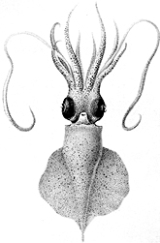
Idioteuthis cordiformis
Encyclopedia
Idioteuthis cordiformis is a species of whip-lash squid
found in tropical regions of the west Pacific Ocean
.
The cuticle is tough and covered with small, conical tubercules on round plaques. The dark red pigment is found in densely packed chromatophore
s but there are no photophore
s. The head is separated from the mantle by a collar and below the head is the opening of the funnel which is ear-shaped. The eyes are large and highly developed, with relatively large lobes of the brain dedicated to their control. The posterior end of the mantle has a semicircular fin on either side which extends three quarters of the way along the mantle.
, Indonesia
, Japan
and the Philippines
.
Whip-lash squid
The Mastigoteuthidae, also known as whip-lash squid, are a family of small deep-sea squid. Approximately 20 known species in two genera are represented, with members found in both the mesopelagic and bathypelagic zone of most oceans...
found in tropical regions of the west Pacific Ocean
Pacific Ocean
The Pacific Ocean is the largest of the Earth's oceanic divisions. It extends from the Arctic in the north to the Southern Ocean in the south, bounded by Asia and Australia in the west, and the Americas in the east.At 165.2 million square kilometres in area, this largest division of the World...
.
Description
Idioteuthis cordiformis is a large, deep water species growing up to one hundred centimetres long. Only a few specimens have been carefully observed and different authorities have described its colour as being pale flesh-pink, yellowish with small reddish-brown chromatophores or having thickly crowded deep brownish chromatophores. It is probably transparent in life with the tissues becoming opaque after death. Like all squids it has five pairs of appendages. Arms 1, 2, 3 and 5 bear suckers with arm 3 being considerably larger than arm 1. Arm 4 is an elongated tentacle which is retractable. It is much longer than the arms and the distal end has a club with many small suckers which decrease in size towards the tip. The club is no wider than the rest of the tentacle.The cuticle is tough and covered with small, conical tubercules on round plaques. The dark red pigment is found in densely packed chromatophore
Chromatophore
Chromatophores are pigment-containing and light-reflecting cells found in amphibians, fish, reptiles, crustaceans, and cephalopods. They are largely responsible for generating skin and eye colour in cold-blooded animals and are generated in the neural crest during embryonic development...
s but there are no photophore
Photophore
A photophore is a light-emitting organ which appears as luminous spots on various marine animals, including fish and cephalopods. The organ can be simple, or as complex as the human eye; equipped with lenses, shutters, color filters and reflectors...
s. The head is separated from the mantle by a collar and below the head is the opening of the funnel which is ear-shaped. The eyes are large and highly developed, with relatively large lobes of the brain dedicated to their control. The posterior end of the mantle has a semicircular fin on either side which extends three quarters of the way along the mantle.
Distribution
Idioteuthis cordiformis is found in tropical waters around AustraliaAustralia
Australia , officially the Commonwealth of Australia, is a country in the Southern Hemisphere comprising the mainland of the Australian continent, the island of Tasmania, and numerous smaller islands in the Indian and Pacific Oceans. It is the world's sixth-largest country by total area...
, Indonesia
Indonesia
Indonesia , officially the Republic of Indonesia , is a country in Southeast Asia and Oceania. Indonesia is an archipelago comprising approximately 13,000 islands. It has 33 provinces with over 238 million people, and is the world's fourth most populous country. Indonesia is a republic, with an...
, Japan
Japan
Japan is an island nation in East Asia. Located in the Pacific Ocean, it lies to the east of the Sea of Japan, China, North Korea, South Korea and Russia, stretching from the Sea of Okhotsk in the north to the East China Sea and Taiwan in the south...
and the Philippines
Philippines
The Philippines , officially known as the Republic of the Philippines , is a country in Southeast Asia in the western Pacific Ocean. To its north across the Luzon Strait lies Taiwan. West across the South China Sea sits Vietnam...
.

